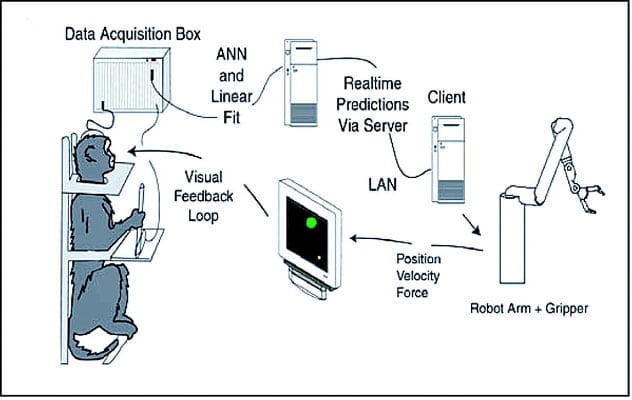
Normally when you experience a stimulus it has to be perceived by your senses, like your eyes or ears, and then travel into your brain to be processed by the associated region of the brain. This is how information is normally processed by your brain and body. However, two neuroscientists from the University of Rochester have recently experimented with brain-machine interfaces and found that it was possible to inject information directly into the brains of monkeys.
The results of the experiment were recently published in the academic journal Neuron, and according to the study electrical stimulation was used to implant information directly into the premotor cortex of the monkeys used as test subjects. The research is still very preliminary, but the University of Rochester researchers hope that their work could pave the way for implants to help treat strokes and neurological diseases.
Marc H. Scheiber, the senior author on the study as well as both researcher and physician at the University of Rochester, says that their work differs from other research into electrical brain stimulation. While most researchers who work on brain stimulation projects focus on the impacts of stimulating the primary sensory cortices (which include the auditory cortex, the visual cortex, and the somatosensory cortex), their work focused on demonstrating that stimulation doesn’t have to be in a sensory-receiving area for the subject to have identifiable experiences.
Playing A Game With Electrodes

Example of a brain-machine interface for monkeys. Photo: Carmena, J.M., Lebedev, M.A., Crist, R.E., O’Doherty, J.E., Santucci, D.M., Dimitrov, D.F., Patil, P.G., Henriquez, C.S., Nicolelis, M.A.L. (2003) Learning to control a brain-machine interface for reaching and grasping by primates. PLoS Biology, 1: 193-208. PLoS is an open-source, peer-reviewed scientific journal publisher. – Figure 1. doi:10.1371/journal.pbio.0000042
The researchers began by training two rhesus monkeys to play a simple game. The game involved having the monkeys carry out tasks based on movement and visual instructions. The researchers showed the two monkeys four different objects, and each one of the objects was illuminated by a light which could be switched off or on. The panel in front of the two monkeys included a button, two different knobs, and a handle. If the lights surrounding the object turned on the monkeys could reach out to the illuminated object and receive a reward.
The various objects within the illuminated holes each required a different action to turn on the light. For instance, the button would glow and demand to be pushed or the cylinder would light up and necessitate being pulled.

Photo: PaulWicks at English Wikipedia, Public Domain
After the researchers had trained the monkeys to play the games, they outfitted the monkeys with a series of electrodes placed within the premotor cortex. Initially, the researchers transmitted a quick, faint burst of electrical stimulation whenever one of the lights turned on. Yet over time, the lights would get dimmer and dimmer until they were eventually turned off completely.
The research team found that the rhesus monkeys were able to perform the correct actions to get the rewards, even though their only stimulus was the electrical microstimulation. This implies that it is possible for to inject information directly into the brain, bypassing the sensory regions altogether and allowing the brain to form the correct response to the stimuli.
‘The monkeys can’t tell us what they are feeling, so training them to associate the microstimulation with a movement is the way we are able to confirm that they have felt an urge or had some kind of experience,’ explains Schreiber.

The researchers experimented with a small monkey species known as the Rhesus Macaque. Photo: Tanuj_hanada via Pixabay
Previous research has demonstrated that electrical stimulus to certain regions of the brain can cause people to respond automatically and involuntarily jerk their limbs. However, the researchers controlled for this and found that this is not what was happening to the monkeys.
One of the most interesting things about the study is that the signals that the researchers injected into the monkeys’ brains had no underlying connection to any of the devices used to get the rewards. The researchers changed things up by reassigning the location of the electrodes, then retraining the monkeys on the lights. After the monkeys had adjusted to one set of rules switching the location of the electrodes meant that the electrodes now fired to indicate completely different objects.
The researchers then experimented with how brief the duration of the electrical pulses could be. Eventually, they were applying electrical jolts that lasted only a fifth of a second, which was too short of a time for the monkeys to respond automatically. Despite this, the monkeys still mastered the version of the game without the lights turned on.
Paul Cheney, a neurophysiologist from the Medical Center at the University of Kansas, concludes that the electrical stimulation is producing some type of conscious perception. What that conscious perception is, however, is still a mystery.
Thereapeutic Applications For Brain-Machine Interfaces
Kevin A. Mazurek, the other lead author on the study, says that the study implies that Brain-Computer Machines/Interfaces could potentially be used in other regions of the brain, outside of the sensory area.
This could be groundbreaking for the development of treatments for stroke and other types of brain damage or illness. The hope is that the damaged part of the brain could be bypassed with a machine, and the relevant information sent to an intact region of the brain using electrodes. Essentially the electrodes could “eavesdrop” on the neuronal activity happening in intact regions, and then send that information to the premotor cortex, for example.
Brain-Machine Interfaces have been integral to improving the lives of people with brain damage or brain diseases. Just recently a BMI called mindBeagle allowed immobilized people incapable of speech to communicate with others. Mazurek and Schieber hope that their work will lead to more advances in this field.
While Schieber and Mazurek worked with tiny arrays of electrodes for this experiment, engineers are working hard to design much larger implantable arrays. There are plans for arrays involving around 1,000 electrodes total. These larger arrays would allow for the transmission of more complex packets of information. The researchers hope that human trials can be done in the near future.
We’re unlikely to have “Matrix”-like systems that allow us to beam the contents of books into our heads anytime soon, but the research could prove to be a boon to both victims of brain damage as well as to brain-machine interfaces as a whole.









